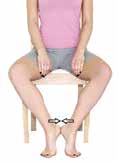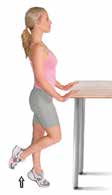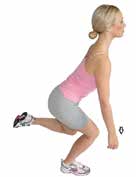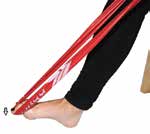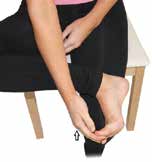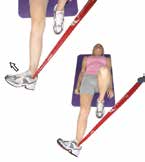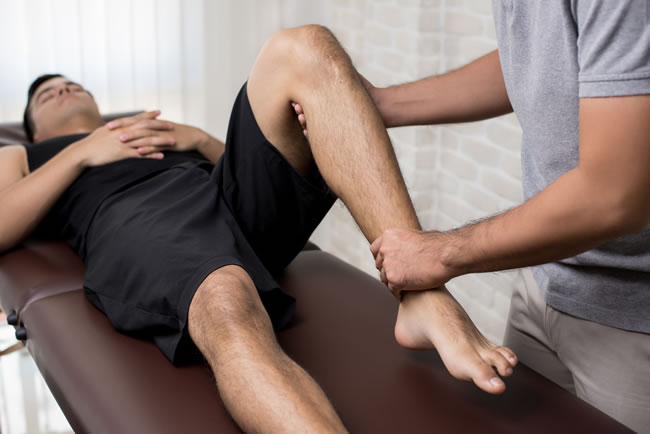THE INJURY
It’s not surprising that about 15% of all running injuries strike the foot. With each step your feet absorb a force several times your body weight. While the foot is in motion during running, the plantar fascia, a thick elastic tissue that stretches from the heel to the base of the toes, works with the Achilles tendon to store and return energy. Because of this powerful attachment, the plantar fascia stabilises the inner forefoot as forces peak during push-off at the end of a stride. Unlike bone spurs and stress fractures of the heel, plantar fasciitis tends to produce pain during the push-off phase while running, and not during initial contact when the foot lands on the ground. Recent research has shown it to be similar to a tendinopathy, where there is a degenerative process involved, including features of collagen breakdown, calcification, nerve and vascular ingrowth. This is why it can sometimes be referred to as plantar fasciopathy.
THE SYMPTOMS
- A sharp stabbing pain or deep ache in the arch of your foot or in the middle of the bottom of your heel.
- Stiffness or pain first thing in the morning (especially when you first get out of bed) that tends to lessen a bit with a few steps, but also tends to worsen as the day progresses and your body fatigues.
- Pain that worsens when climbing the stairs or standing on one’s toes.
- It is a notoriously nagging injury, and running through it, while possible, can delay healing. Often once you have warmed up and started running the pain eases only to return towards the end of a long run or later that day. Take care, this can become a vicious cycle.
THE CAUSE
Plantar fasciitis may result from a variety of factors, such as overtraining, doing vigorous repeated hill workouts or speed work, neglecting to stretch tight calf muscles, wearing unsupportive shoes, starting a running programme too aggressively or a general lack of foot strength.
It can also be attributed to biomechanical factors such as fallen arches. The excessive lowering of the arch in flat-footed runners increases tension in the plantar fascia and overloads the attachment of the plantar fascia to the heel bone, leading to eventual inflammation. Other biomechanical factors include an inward twisting or rolling of the foot (pronation) and tight tendons at the back of the heel (Achilles tendon), with reduced ankle dorsiflexion (upward movement of the ankle) and poor foot flexion and eversion (twisting ankle outwards) strength.
THE FIX
Plantar fasciitis is considered a self-limiting condition of variable duration. With treatment, symptoms usually improve over 3-6 months. However, patients performing prolonged standing and painful loading of the tissue may require longer, up to 9 or 12 months. Treatment includes mobilising tight structures and fascia and strengthening the foot muscles:
- Lightly stretching and mobilising the fascia throughout the day by, rolling your foot over a golf ball or over a frozen water bottle. Manually stretching your foot by pulling your toes back is particularly useful first thing in the morning.
- Wear supportive footwear with enough shock-absorbing cushioning through the day and avoid prolonged standing, especially on hard surfaces.
- Physical therapy to mobilise and release tightened fascia on the foot, as well as the ankle joint, calf and Achilles tendon.
- Massage therapy to release tight structures of the lower limb and foot.
- Night splints (including the Strassburg Sock), which holds the foot with the toes pointed up and the ankle at a 90-degree angle, can reduce morning symptoms
- Performing prescribed stretching and strengthening exercise for the foot and the hip/pelvis and your core.
- Cross train with water running, swimming, elliptical and cycling.
- For severe cases surgery may be required to release the fascia, but this is needed in less than 5% of cases.
THE PREVENTION
Run on a variety of surfaces, especially softer surfaces such as dirt paths, grass or trails, rather than concrete or asphalt. Make sure your running shoes are the right fit and support for your gait by going to a speciality running store and getting a properly fitted pair. Ensure your training programme is right for your ability. Lastly, foot-strengthening exercises can go a long way to reducing future injuries. Tight hip flexors, a weak core and a history of low back pain can all contribute to injury – any of these issues can lead to subtle changes in your stride that you’ll feel in your feet. Have these issues addressed with physical therapy and a rehabilitation programme.
YOUR REHABILITATION PROGRAMME
This programme has specific exercises for Plantar Fasciitis. You want to focus on stretching the fascia, whilst strengthening the foot muscles and ankle. Don’t forget the importance of strengthening the entire leg too! It is important to ensure the exercises are performed with good technique and good postural control. Make sure to repeat the same number of exercises on both legs. Make sure you are always pain-free and take care not to progress too quickly. We have given suggested sets and repetitions, and the exercise routine should be performed twice a day. Remember everyone is different so your therapist may give guidance.
WARM UP AND COOL DOWN
If muscles are tight, weak or injured, it is particularly important to warm up (unless advised otherwise by your practitioner) with a brisk walk or a gentle jog at a pain-free pace for 5 minutes before you start your exercises. This increases your circulation and helps prepare the muscles for the activity to come. When you have finished your exercises, end the session with a 5 minute gentle walk or slow jog to allow your heart rate to slow down gradually.
PLANTAR FASCIA STRENGTHENING
In sitting, lift your heels on to the balls of your feet or your toes. Press your heels against each other. You will feel a contraction in the soles of your feet, used as a strengthening exercise to the plantar fascia and intrinsic foot muscles.
Repeat 10 times | Hold for 5 seconds
Video: http://youtu.be/nHZusrfZC7Y
CALF RAISES ONE LEG
Stand upright on one leg. Slowly raise up onto your toes, and control the movement back down. Hold on to a wall or table for support. This exercise will strengthen the calf muscle and ankle joint. You can progress this exercise by rolling a small towel up and placing it under your toes, then proceed with a calf raise.
Repeat 12 times | Perform both sides
Video: http://youtu.be/QEILIo9Kzlw
FULL SQUAT SINGLE LEG
Stand on one leg, and bend your knee to the full squat (90 degrees) position. Make sure when you squat you keep the middle of your knee cap in line with the middle toes of your foot. Do not let your knee drift off to one side. Also keep your hips and pelvis level as you squat, so you go down in a straight line. Be careful not to slump forwards as you squat, and maintain good posture. Always keep your foot flat on the ground, do not let your heel raise up.
Repeat 6 times | Perform both sides
Video: http://youtu.be/afJNrDNonAc – that is more specific to you.
BIG TOE FLEXION BAND
Place a thin band around your big toe, and push the toe downwards creating resistance in the band. This exercise will help you gain strength and mobility to your big toe.
Repeat 12 times | Perform both sides
Video: http://youtu.be/eglt_FZ5HLs
TOE EXTENSION PASSIVE
Using your hand, bend your toe(s) upwards. This will help improve mobility to your toes. You can also hold the stretch too if you wish.
Repeat 3 times | Hold for 30 seconds | Perform both sides
Video: http://youtu.be/uwJJt0XdXmo
EVERSION WITH BAND
Tie an exercise band around a stable object, and tie the other end around the outside of your foot. Move your foot outwards and upwards against the resistance of the band. This is a strengthening exercise for your ankle. Repeat this exercise in the opposite direction – INVERSION – turn yourself around so that you move your ankle inwards and upwards against the resistance of the band.
Repeat 12 times | Perform both sides
Video: http://youtu.be/LPL8bCiLJag
The information contained in this article is intended as general guidance and information only and should not be relied upon as a basis for planning individual medical care or as a substitute for specialist medical advice in each individual case. ©Co-Kinetic 2017
Start your journey to a healthier, stronger body today!
RESTORATION
Once we have got you to a stage where you injury is healed, we then give you a rehabilitation programme to restore your strength and enable you to resume your sporting activities.
prevention
Are you currently engaging in sport but worried about getting injured in the future? Why not work with us so we can help get your body strong and supple to minimize any disruption to your exercise routine?


